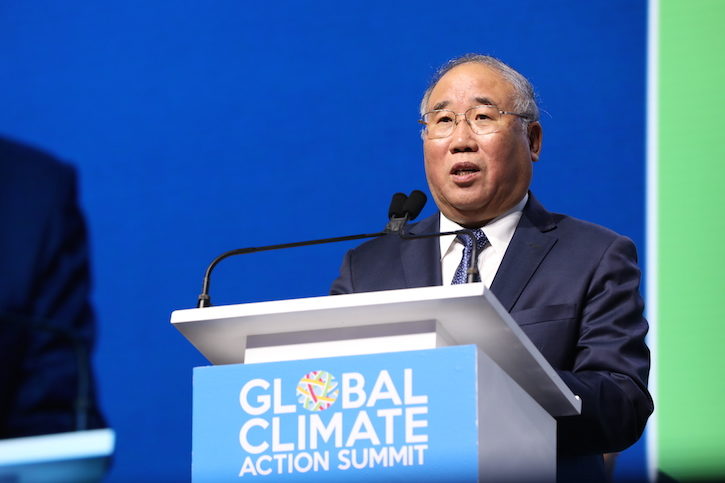
California Governor Jerry Brown began and closed the 2018 Global Climate Action Summit (GCAS) to much fanfare—signing of the 100 Percent Clean Energy Act of 2018 and the state’s intent to launch its own satellite. The GCAS was a three-day stage to highlight climate change challenges and bring global stakeholders together to begin to take action. It was a galvanizing platform to raise awareness and a call to action for subnational entities and non-state actors, especially industry.
Industry made their presence felt at GCAS with numerous commitments announced including New York City’s pension funds promising to double climate-solutions-related investments to $4 billion from $2 billion in the next three years, 21 leading technology firms joining the Step Up Coalition, and Levi Strauss seeking to cutting emissions by 90% in its facilities as part of the We Are Still In campaign. Corporate leaders from Salesforce, Mahindra Group, Starbucks, and Unilever were on hand to deliver the message that global businesses stand ready to play their part in climate action.
China’s Special Representative for Climate Change Affairs, Xie Zhenhua served as one of Governor Brown’s co-chairs for the GCAS and led a delegation of more than 120 Chinese government officials, business leaders and academics to the summit. As the world’s largest carbon emitter, China’s presence at the GCAS was not only necessary, but also an important signal for the scaling of practical global climate action solutions.
The China Pavilion at the GCAS was one of the summit’s affiliated events and was organized the State of California and China’s Ministry of Ecology and Environment with support from the Energy Foundation China. It was the nexus of China’s climate action efforts at the summit, featuring GCAS headliners and a full three-day agenda. Former Vice President Al Gore, Governor Brown, and Executive Secretary for the UN Framework Convention on Climate Change (UNFCCC) Patricia Espinosa joined Xie in kicking off the important discussions at the China Pavilion. The ambitious agenda covered climate finance, low carbon development on the subnational level in China, progress of the national carbon market and emissions trading system, energy efficiency, green transportation, and the role of the private sector in enacting climate action.
The top-line observation from the breakout sessions and presentations of the China Pavilion is that China will continue to prioritize heavily its efforts not only for climate action, but also in addressing environmental challenges more broadly.
On multiple fronts, China has already began to take action. It is a top manufacturer of renewable energy and green transportation producing 60% of solar panels worldwide last year and is on track to sell one million new energy vehicles by the end of the year respectively. It is also a leader in promoting green finance and sustainable cities. Yet there is still a long way to go.
China displayed its commitment to climate action with the launch of the Climate Action by Chinese Enterprises Initiative and an investment fund at the GCAS in response to Xie’s proposal for climate action, which called for Chinese enterprises to take the lead in carbon reduction, green transformation, and green innovation to promote sustainable growth and development. The Initiative is sponsored by 21 foundations, environmental organizations, and industry associations that represent 800,000 Chinese enterprises. The Vanke Foundation, Broad Group, and WWF Beijing Office among others, are part of the Initiative that pledges to implement the eight strategies that Xie’s proposal outlined.
Specifically, Xie called for:
- Strengthening carbon management and carbon information disclosure;
- Promotion of renewable energy technologies and promoting the use of renewables;
- Promotion of green manufacturing and low carbon cycle development to gain knowledge and create technologies to reduce emissions from waste;
- Promoting sustainable development by building green supply chains;
- Improving building energy efficiencies and reducing energy consumption by promoting green ecological planning and design;
- Promoting green transportation;
- Promoting the choice of green consumption; and
- Promoting carbon markets, carbon trading, and green finance.
The California and China Clean Technology Innovation Fund was also announced at GCAS. Specific details for the fund are still in development, but it is slated to contain four sub-funds that include Beijing, Shenzhen, Jiangsu and Chinese solar manufacturer GCL working with the state of California. The new fund intends to further encourage cleantech innovation. These tangibles highlight the significance of collective action that leverages ideas and expertise of the private sector and other non-state actors.
Further commitments to climate action were defined in a number of memorandum of understanding (MOU) that were also signed at the GCAS. The MOUs focus on joint research and project collaborations is supporting China’s carbon market development, low-carbon transition, and capacity building in the construction of a global climate governance system.
The GCAS featured more than 500 commitments encompassing a number of interested stakeholders. What does this mean? Do we now have a better likelihood of fulfilling the goals outlined in the Paris Agreement? As the memories of the GCAS fade and participants return to their respective norms, now is time for execution.
The summit successfully brought stakeholders to the table to draft concrete plans for addressing climate action so follow up at the UN General Assembly and the UNFCC’s COP24 gathering in December are par for the course, but a more likely benchmark for GCAS commitments could be the United Nations Climate Summit in September 2019. It will truly take a village to act against climate change.




